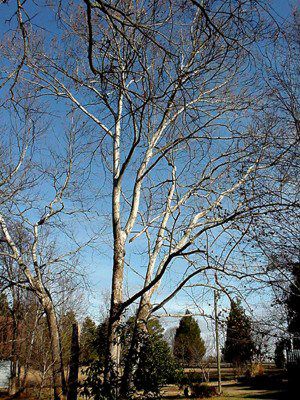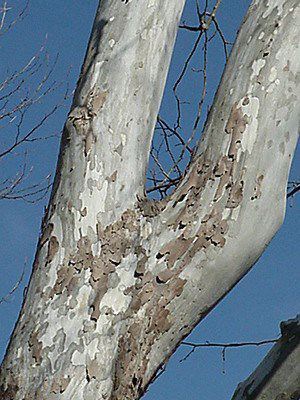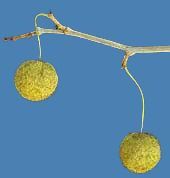|
|
|||
|
THIS WEEK at HILTON POND Installment #---Visitor # (Back to Preceding Week; on to Next Week) |
|
American Sycamore After last week's discovery of a skeletonized leaf at Hilton Pond Center, we were reminded of how interesting a tree is the American Sycamore, Platanus occidentalis.
Sycamores do look nice in urban settings, and there are a few "young" 30-foot specimens we've been watching grow at Hilton Pond Center, but our greatest sycamore pleasures come as we encounter the species during winter walks in the Piedmont. Wandering local woods, we often follow streams and watersheds, observing the microclimates that influence vegetation on slopes and hillsides. In nearly all of our deciduous bottomlands we get a visual treat from sycamores lined up along the streams in their winter "dress white" uniforms. By December, while most of our naked trees reveal black or brown or gray bark, the trunk of the sycamore shines with unusual whiteness; it's a real joy to gaze at sycamores reflecting the brilliance of the winter sun--all in very sharp contrast to the dark background of the rest of the woods.
The outer secondary trunks of a sycamore have better access to available sunlight, so the innermost trunk often dies, providing excellent homesites for cavity- dwelling animals. Sycamores produce fruit in pendant ball-shaped structures (right) about an inch in diameter, but their tiny seeds provide little nourishment. Nonetheless, flocks of Purple Finches frequently descend on sycamores in mid-winter, tearing open the balls, gorging on seeds, and scattering snow-like seed fluff everywhere. Along waterways, sycamores grow rapidly into massive specimens with perhaps the biggest main trunks of any Piedmont tree. In uncut woodlands, it's not unusual to find sycamores with trunks four feet across, and riverside sycamores in the Great Smoky Mountains reach at least 8 feet DBH (diameter at breast height). Some of the biggest sycamores in South Carolina grow in the Congaree Swamp floodplain just southeast of Columbia. There the trees are so old and large that one has to use binoculars to see 75 feet high on the main trunks; only at that height can you begin to find the white bark and branches typical of the smaller, younger trees with which most folks are more familiar.  |

 This species, also called American Plane Tree or Buttonwood, is native to the eastern United States and even occurs in the cooler elevation of Mexico's mountains. Often planted as an ornamental in cities and suburban areas, the sycamore grows rapidly and its broad maple-like leaves soon cast dense shade. Although many city-dwellers welcome the tree and the shelter it provides from summer heat, its leathery, large, maple-shaped leaves--up to 8 inches or more across--are difficult to rake and don't seem to decompose very rapidly. (Solution: Don't rake!)
This species, also called American Plane Tree or Buttonwood, is native to the eastern United States and even occurs in the cooler elevation of Mexico's mountains. Often planted as an ornamental in cities and suburban areas, the sycamore grows rapidly and its broad maple-like leaves soon cast dense shade. Although many city-dwellers welcome the tree and the shelter it provides from summer heat, its leathery, large, maple-shaped leaves--up to 8 inches or more across--are difficult to rake and don't seem to decompose very rapidly. (Solution: Don't rake!) Older sycamores have a rich brown main trunk, which typically branches into several secondary trunks (see photo above) that shed outer layers to reveal the white inner bark characteristic of the species. Usually, the ground beneath a sycamore is littered by outer bark flakes resembling large jigsaw puzzle pieces, each with unique textures and shapes.
Older sycamores have a rich brown main trunk, which typically branches into several secondary trunks (see photo above) that shed outer layers to reveal the white inner bark characteristic of the species. Usually, the ground beneath a sycamore is littered by outer bark flakes resembling large jigsaw puzzle pieces, each with unique textures and shapes. Any uneaten small seeds, disseminated mostly by wind, can blow for hundreds of yards, perhaps germinating the next spring.
Any uneaten small seeds, disseminated mostly by wind, can blow for hundreds of yards, perhaps germinating the next spring.